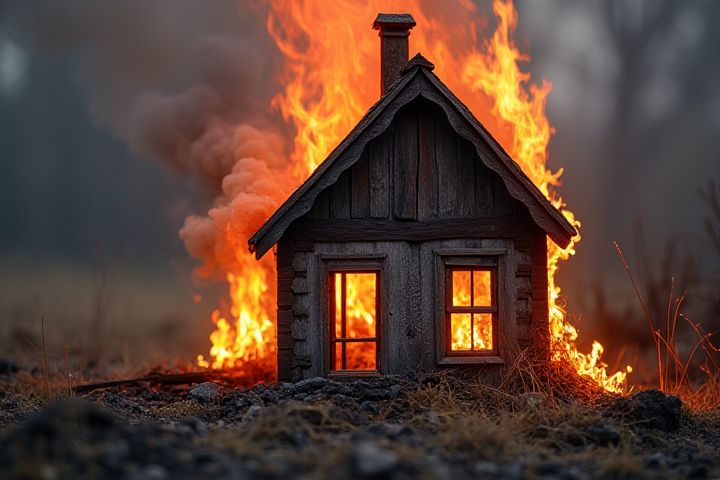
A house can be made fireproof by incorporating specific materials and techniques during construction. Using fire-resistant materials such as concrete, steel, and treated wood significantly enhances the building's safety. Installing fire-rated windows and doors can also help prevent flames from entering the structure. Additionally, applying fire-retardant coatings to the exterior and utilizing non-combustible insulation reduces fire risk further. To maximize protection, ensure that landscaping around your home includes fire-resistant plants and proper spacing to create defensible space.
Can A House Be Made Fireproof
Fire-resistant materials
Fireproofing a house is achievable by utilizing fire-resistant materials such as concrete, brick, and specialized fire-retardant treated wood. Concrete can withstand temperatures up to 2,500degF, making it an ideal choice for walls and foundations. Moreover, steel framing, which maintains structural integrity up to 1,200degF, is another excellent option for enhancing a home's fire resistance. Installing tempered glass windows that can endure heat better than standard glass further increases safety, while flame-resistant roofing materials like slate or metal can protect your roof from ember attacks.
Non-combustible roofing
Non-combustible roofing materials significantly enhance a house's fire resistance, offering a crucial defense against wildfires and spreading flames. Options such as metal, slate, and tile have a Class A fire rating, which indicates the highest level of fire resistance according to the Underwriters Laboratories (UL) standard. Choosing a non-combustible roofing system can reduce insurance premiums, as many insurers recognize the lower risk associated with fire-resistant homes. In areas prone to wildfires, implementing a non-combustible roofing solution can increase your property's overall safety and longevity.
Fire-rated windows and doors
Fire-rated windows and doors are specifically designed to withstand high temperatures and prevent the spread of flames, making them essential for enhancing a house's fire safety. Fire-rated doors typically come with a fire-resistance rating of 20 to 90 minutes, while fire-rated windows can endure temperatures up to 1,700degF for a limited time. Installing these features not only safeguards your home but also complies with local building codes, which often mandate fire-resistant materials in certain zones. By integrating fire-rated components, you effectively create a protective barrier, significantly increasing your home's resilience against fire hazards.
Proper insulation
Proper insulation plays a crucial role in enhancing a house's fire resistance. Utilizing materials such as mineral wool, fiberglass, or closed-cell spray foam significantly reduces the flammability of structural elements. Fire-resistant insulation not only mitigates heat transfer during a fire but also slows the spread of flames, protecting vital areas of your home. By choosing the right insulation and ensuring proper installation, you can create a safer living environment that withstands the risks of fire.
Firebreak landscaping
Firebreak landscaping is an effective strategy for creating fire-resistant zones around your home, significantly reducing the risk of wildfires. By maintaining a minimum clearance of 30 feet from your house, you can drastically lower the chances of embers igniting nearby vegetation. Utilizing fire-resistant plants, such as succulents or native species, further enhances your landscaping's ability to withstand flames. Implementing hardscaping elements like gravel, stone pathways, or retaining walls can serve as additional barriers, minimizing fire spread and protecting your property.
Sprinkler systems
A fireproof house can incorporate advanced sprinkler systems designed to effectively mitigate fire risks. These systems, which spray water when heat is detected, can significantly reduce fire spread and improve safety in residential properties. Modern sprinkler technology includes features such as zoning, allowing targeted response to specific areas of the home. By installing a comprehensive sprinkler system along with fire-resistant materials, you can enhance your home's overall fire protection strategy.
Sealed vents and gaps
Sealed vents and gaps are crucial elements in making a house fireproof, as they minimize the potential for flames and embers to enter the structure. Fire-rated sealants and intumescent materials can be used to seal gaps around windows, doors, and utility penetrations, providing enhanced protection. Regular inspection and maintenance of these sealed areas can reduce your home's vulnerability to fire, increasing safety and potentially lowering insurance premiums. Implementing these measures effectively creates a more secure environment, contributing to a resilient fire safety strategy.
Fire-resistant siding
Fire-resistant siding significantly enhances a home's fire safety, utilizing materials like fiber cement, stucco, or metal. These materials are engineered to withstand high temperatures, offering protection against flames and radiant heat. Studies have shown that homes with fire-resistant siding can reduce the risk of fire damage by up to 60%. By choosing fire-resistant siding, you not only increase your property's safety but can also lower potential insurance premiums.
Minimized overhangs
Minimized overhangs significantly contribute to enhancing a house's fire resistance by reducing the amount of surface area exposed to direct flames and embers. When roofs and eaves are designed with shorter overhangs, they limit the potential for flames to catch and spread, particularly during wildfires. This design choice not only protects the structural integrity of the building but also minimizes the risk of igniting adjacent vegetation or other flammable materials. By selecting materials resistant to heat and utilizing efficient landscaping techniques, you can further bolster your home's fireproofing strategy while maintaining aesthetic appeal.
Regular maintenance
Regular maintenance plays a crucial role in enhancing a house's fireproof capabilities. Homeowners should inspect and clear gutters and roofs of debris at least twice a year to reduce fire hazards. Additionally, maintaining landscaping by trimming trees and shrubs, ideally keeping them at least 30 feet away from the structure, minimizes potential fuel for wildfires. You should also check and update your fire-resistant materials, such as siding and roofing materials, to ensure they meet the latest building codes and standards for fire safety.
